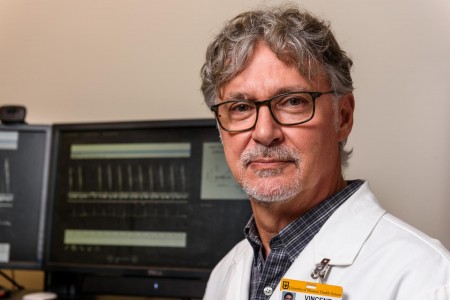November 2003 - The discovery that a protein present only on the surface of a select group of T-cells functions to inhibit aggressive immune responses could have important implications for organ transplant patients and patients with autoimmune diseases, and could prove equally relevant in the development of vaccines for the treatment of cancer, drug-resistant tuberculosis, HIV infections and other viral diseases. The findings from animal studies at Beth Israel Deaconess Medical Center (BIDMC) and Brigham and Women's Hospital (BWH) are described in two separate papers in the November 2003 issue of Nature Immunology.
Known as Tim-3 (T cell immunoglobulin domain, mucin domain), the proteins in question are found on the surface of TH1-helper type T cells, which when activated become the body's first line of defense against foreign microbes.
"Activated TH1-type helper T cells both participate in and help orchestrate the attack on cells bearing proteins, thereby guarding against infection," explains Terry Strom, MD, Chief of Immunology at BIDMC and Professor of Medicine at Harvard Medical School. "Nature gave us these cells as a critical defense against microbes."
However, he adds, these same T-cell responses must always be carefully balanced -- left unchecked, they can become overly aggressive, leading to inflammatory tissue injury and resultant autoimmune diseases, including diabetes, rheumatoid arthritis and inflammatory bowel disease. Similar problems develop among transplant patients when T-cells mount unnecessary defenses against their new organs, leading to organ rejection.
The two Nature Immunology papers, by senior authors Strom and BWH immunologist Vijay Kuchroo, DVM, PhD, found, for the first time, that Tim-3 proteins selectively serve as "checkpoints" for the immune system, helping to keep activated TH1 T-cell responses under control. Kuchroo is Associate Professor of Neurology at Harvard Medical School.
Continue Reading Below ↓↓↓
"Knowing that these proteins are not found on the surface of either [non-activated] resting T-cells or on activated T-cells other than TH1 helper cells, we hypothesized that Tim-3 served to limit and control ongoing TH1-dependent immune responses," explains Strom. "The particular pattern of Tim-3 expression that was found in these two studies suggests that it plays a key role in squelching activation of TH1 T-cells. Nature must have wanted us to have such a mechanism so that once you have created immunity, you have a timely means of 'turning off' the immune attack," he adds.
Strom and his colleagues looked at autoimmune diabetes in mice, a condition known to be caused by a TH1 response against insulin-producing cells. In a mouse model of tissue transplants, they found that mice with no Tim-3 rapidly rejected the transplants, despite receiving treatments that normally ensured transplant survival. Likewise, in their paper, Kuchroo and colleagues demonstrated that Tim-3 deficiency prevented mice from acquiring a state of "immune tolerance," which can normally be attained by administering high doses of protein.
"This clearly shows that one of the primary functions of the Tim-3 molecule is not only to regulate the expansion of TH1 cells, but also to regulate induction of tolerance in these cells," explains Kuchroo. "The method to block the Tim-3/Tim-3L interaction with the soluble Tim-3Ig, though not useful for autoimmunity, may prove very useful in enhancing anti-tumor immunity and anti-microbial immunity." Strom adds that the new findings suggest two important ways in which the Tim-3 pathway could be harnessed: First, by enhancing the Tim-3 signal, the response of TH1 cells could be diminished, thereby creating immune tolerance, and squelching the development of autoimmune diseases or preventing organ rejection.
And second, by blocking the Tim-3 pathway, TH1 responses could be amplified, thereby helping the immune system mount a more vigorous attack against foreign microbes or tumor cells, which could prove to be an important application when used in vaccine development, for example.
"From a therapeutic perspective, the implications of these new findings are intriguing," says Strom.
The Strom study was funded by the Juvenile Diabetes Research Foundation, the National Institute of Allergy and Infectious Diseases and the Center for Islet Transplantation at Harvard Medical School; the Kuchroo study was funded by the National Multiple Sclerosis Society and the National Institutes of Health.
Co-authors of the Strom paper include lead investigator Alberto Sanchez-Fueyo, MD, Christoph Domenig, MD, and Xin Xiao Zheng, MD, of Beth Israel Deaconess Medical Center; Jane Tian, Dominic Picarella, Jose-Carlos Gutierrez-Ramos, PhD, and Anthony Coyle, PhD, of Millennium Pharmaceuticals, Cambridge, Mass.; Catherine Sabotos, MSc, and Vijay Kuchroo, DVM, PhD, of Brigham and Women's Hospital; Natasha Manlongat of Hammersmith College, London; and Orissa Bender and Thomas Kamradt of Deutsches Rheumaforschungs Zentrum, Berlin. Co-authors of the Kuchroo paper, in addition to Catherine Sabotos, MSc, include BWH researchers Sumone Chakravarti, PhD, Eugene Cha, BA, and Anna Shubart, PhD; and Gordon Freeman of the Dana-Farber Cancer Institute.
Source: Beth Israel Deaconess Medical Center










